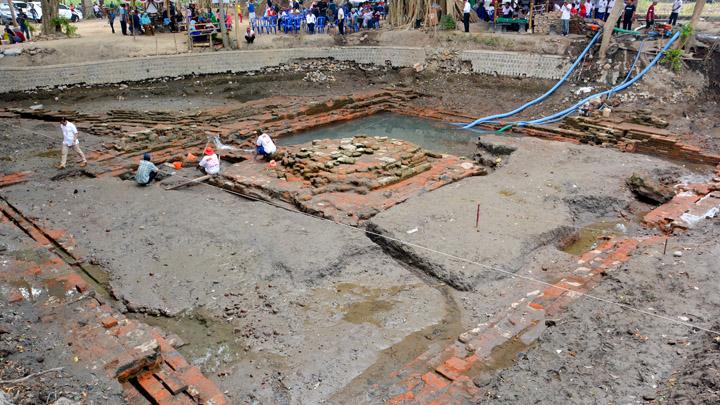
TEMPO.CO, Jakarta - Prehistoric cave paintings were discovered in Sangkulirang - Mangkalihat, East Kalimantan. The cultural preserve might become a UNESCO World Cultural Heritage Site.
The heat was biting when Tempo arrived at the mouth of Gua (Cave) Tewet at the foot of Mount Gergaji, East Kalimantan, mid-April. Ten steps into the cave, on a 4.8-meter tall wall, we spotted a blackish-red drawing of a human palm about the size of the average human hand, 20 centimeters in length and 13 centimeters wide. Two meters forward, we found images of human palms in abundance on the cave wall, a few centimeters above eye level.
The walls of Gua Tewet measure around 137 square meters, and on it are more than 50 ancient cave paintings, mostly of the human hand and deer-like creatures, all still in pristine condition.
Mount Gergaji's parietal art was discovered by locals decades ago. But the discovery was made known to the public only in 1994, when local and overseas scholars assisted by Pindi Setiawan, a cave painting researcher from the Bandung Institute of Technology's School of Fine Arts and Design, became interested in studying the prehistoric site.
It was from these researchers that the locals learned the caves they used as resting spots while on a hunt for swallow nests held the masterpieces of humans from a very ancient time. "We locals had no idea, even though we often viewed the paintings every time we made a stop at the caves," said Johan, 42, a resident of the Tepian Langsat village, East Kutai. Johan's home is on one of the access roads to the caves.
Traveling to Gua Tewet, located about 1,000 meters above sea level, is no easy task. After a seven-hour drive to Jalan Hambur Batu from Samarinda, a visitor must take a motor boat to cross the Bengalon River--a three-hour-trip--to reach a base camp at the foot of Mount Gergaji. The base camp belongs to the East Kalimantan Agency for Cultural Heritage Preservation. Finally, one must walk past a number of steep inclines and a cliff almost 80 degrees in declivity.
Tewet is one of scores of caves in the Sangkulirang-Mangkalihat karst area in East Kutai that preserve prehistoric cave paintings. Besides Gua Tewet on Mount Gergaji, parietal art can also be found in the caves of Mount Pengadan and Mount Batu Nyere, also in Sangkulirang-Mangkalihat. Extensive research from 1994 to 2006 found some 37 sites with cave paintings in the area, mostly found in caves at heights of 700-1,000 meters above sea-level
According to Cecep Eka Permana, an archeologist from the University of Indonesia, cave paintings in the Sangkulirang-Mangkalihat karst area can be considered special. Based on preliminary research, Cecep assessed that these cave paintings are the oldest in the world. Previously, cave art in Gua Timpuseng, South Sulawesi, were thought to be the world's oldest at 39,900 years old, older than cave paintings found in France, estimated to be 39,700 years old. "I estimate the cave paintings in the Sangkulirang-Mangkalihat karst area to be (even) older," Cecep said.
Parietal art comprises images made by prehistoric humans on stone surfaces in the form of paintings, drawings, and carvings. According to Cecep, the word 'drawing' is used as a neutral and general term to cover all types of prehistoric art, while 'stone surfaces' can mean cave walls or large blocks of stone.
According to Pindi Setiawan, Sangkulirang-Mangkalihat's parietal art might have been created by a pre-Austronesian race who lived during the Ice Age, 40,000-10,000 BC. They were proto- and deutero-hunters," said Pindi, who has been visiting the site since 1994.
The pre-Austronesians made their journey from the North (Taiwan) to the south, most probably to Vietnam, Sarawak, Sabah and finally to Sangkulirang. Creators of these cave paintings came before the arrival of the Austronesians, who would become the ancestors of most of the present-day Dayak people.
In Sangkulirang, the cave painting creators seemed to concentrate activity in Mount Gergaji and its vicinity. Apart from Gua Tewet, parietal art is also found in nearby Gua Karim. Although more cave paintings are found in Gua Tewet, Gua Karim tends to show more variety. Gua Karim's cave paintings do not only include human palms, but also bee-hives and trees, as well as animals endemic to East Kalimantan, such as tapir and deer.
Read more inspiring Outreach stories in Tempo English Weekly Magazine























